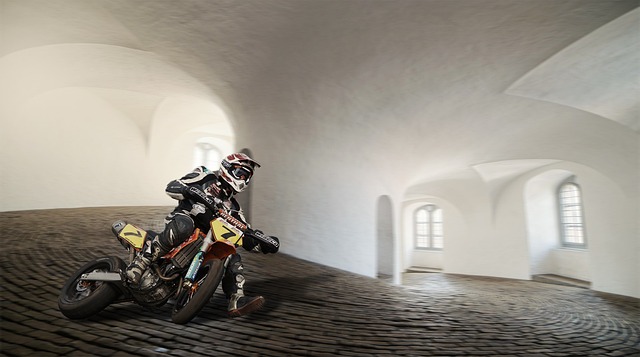In Tucson, maintaining the safety and proper functioning of garage doors is critical, especially considering the unique environmental conditions that can affect sensor performance. Regular calibration and adjustment of photo eyes and force sensors on Tucson Garage Doors are necessary to ensure they operate correctly and prevent accidents. This involves cleaning sensor lenses, aligning photo eyes within the manufacturer's specified range, and testing the door's reverse mechanism upon encountering an obstruction. It's also important to check and adjust the tension on springs and cables for force sensors to detect any resistance or obstruction. Homeowners should follow the user manual for detailed adjustment procedures and consider professional services for complex repairs. Routine upkeep includes cleaning sensors, inspecting electrical connections, and conducting monthly tests to confirm safety features are functioning as intended. Professionals use specialized tools for calibration, which is essential for maintaining high safety standards for Tucson Garage Doors and their surrounding environments. Regular maintenance not only ensures safety but can also potentially extend the lifespan of the garage door system.
When it comes to safeguarding your home, the integrity of your garage door sensors plays a pivotal role. This article delves into the essentials of sensor installation and fine-tuning for Tucson Garage Doors, ensuring top-notch safety measures are in place. We’ll explore the different types of sensors available, offer a comprehensive guide to their installation, and provide tips on maintaining optimal performance. With a focus on Photo Eyes vs. Motion Detectors, and the steps needed for calibration and adjustment, homeowners in Tucson can rest easier knowing their garage doors are secure.
- Understanding the Importance of Sensor Installation and Adjustment for Tucson Garage Doors Safety
- Types of Sensors for Tucson Garage Doors: Photo Eyes vs. Motion Detectors
- Step-by-Step Guide to Installing Sensors on Your Tucson Garage Doors
- How to Calibrate and Adjust Sensors to Optimize Safety Features for Your Tucson Home
- Maintenance and Best Practices for Ensuring Continuous Performance of Sensors with Tucson Garage Doors
Understanding the Importance of Sensor Installation and Adjustment for Tucson Garage Doors Safety

Proper sensor installation and adjustment are paramount for the safety of residential garage doors in Tucson. These sensors, commonly known as photo eyes, are critical components that ensure a garage door operates safely by preventing it from closing on vehicles, pets, or people. The photo eyes emit an invisible laser beam across the doorway, which, when broken, halts the door’s motion. Homeowners in Tucson can significantly enhance the safety of their garages by ensuring these sensors are correctly installed at the proper height, aligned correctly, and sensitive to various objects’ presence. Regular checks and fine-tuning of the sensor settings can detect any misalignment or sensitivity issues before they lead to potential accidents. This meticulous approach not only upholds the integrity of Tucson Garage Doors but also provides peace of mind for residents, knowing that their garage doors will function securely and reliably.
Furthermore, adjusting the sensors on Tucson Garage Doors is not a one-time task; it’s an ongoing process that adapts to changes in the environment, such as temperature shifts or the accumulation of dust and debris. This maintenance ensures the sensors maintain optimal performance, reflecting the commitment of local homeowners to upholding the highest safety standards. It’s advisable for residents to familiarize themselves with their garage door models’ specific sensor requirements and to consult professional assistance when necessary. By staying proactive with sensor installation and adjustment, Tucson residents can effectively safeguard their homes and belongings against unintended closures or malfunctions, thus contributing to the overall safety of their neighborhoods.
Types of Sensors for Tucson Garage Doors: Photo Eyes vs. Motion Detectors

When considering the enhancement of safety for Tucson garage doors, understanding the types of sensors available is crucial for homeowners. Two primary types of sensors that significantly contribute to the safety and functionality of automatic garage door systems are photo eyes and motion detectors.
Photo eyes, also known as safety eyes, are typically installed at the sides of a garage door opening. These sensors work by emitting an infrared beam across the garage door’s path. If this beam is interrupted, perhaps by an object or a person, the garage door will automatically reverse its closing motion, thereby preventing potential injury or damage. This failsafe mechanism is a requirement under modern safety standards and is essential for ensuring the well-being of individuals and pets within the vicinity of Tucson garage doors.
In contrast to photo eyes, motion detectors are designed to sense movement in different areas of the garage. These sensors can be more complex, sometimes incorporating technology that distinguishes between living creatures and inanimate objects to reduce false alarms. Motion detectors can be used in conjunction with photo eyes for a comprehensive safety system. They offer an added layer of security by alerting homeowners to unexpected activity within the garage, which can be particularly useful when one is away from home. For Tucson garage doors, the choice between these two types of sensors should be based on the specific needs and layout of the garage, as well as the level of security desired. Proper installation and regular maintenance of these sensors by qualified professionals are key to maintaining optimal safety for your Tucson garage door system.
Step-by-Step Guide to Installing Sensors on Your Tucson Garage Doors

When enhancing the safety and security of your home in Tucson, installing sensors on your garage doors is a crucial step. This guide will walk you through the process of installing sensors effectively to ensure your garage doors are secure. Begin by choosing the right sensors for your Tucson Garage Doors; opt for those that are designed to detect any unexpected movements or forceful entries. Ensure you have all necessary tools and equipment, including screwdrivers, a drill, and the sensor kit itself.
Start by turning off the power supply to your garage door opener to avoid any electrical hazards. Carefully remove the cover of your Tucson Garage Door opener, typically found on the ceiling of your garage. Affix the mounting bracket of the sensor kit onto the opener where indicated, securing it with screws. The sensors should be positioned so that they can monitor the garage door’s motion and any potential intrusions. Once the sensors are securely mounted, reattach the cover to shield them from dust and debris.
Next, connect the wiring as per the sensor kit’s instructions, ensuring a solid connection to both the opener and the sensors. With everything wired up, turn on the power and test the sensors by closing and opening your garage door. The sensors should trigger the garage door opener, reversing its motion if an obstacle is detected. It’s important to adjust the sensitivity settings according to the manufacturer’s recommendations or as needed for optimal performance. Regular maintenance checks will help ensure that your Tucson Garage Door sensors remain sensitive and effective in protecting your home.
How to Calibrate and Adjust Sensors to Optimize Safety Features for Your Tucson Home

In Tucson’s often-warm climate, ensuring the safety and functionality of your home’s garage doors is paramount. Regular calibration and adjustment of sensors are critical steps in maintaining the optimal performance of these doors. Homeowners should familiarize themselves with the mechanisms behind their Tucson garage doors’ safety features, particularly photo eyes and force sensors. These components work in tandem to prevent accidents such as closing on objects or individuals. To calibrate the sensors, begin by cleaning the lenses with a soft, dry cloth to remove any accumulated dust or debris that might interfere with their operation. Once cleaned, use the adjustment screws on the side of the photo eyes to align them so they are facing each other directly. The distance between these eyes should be as per the manufacturer’s specifications, typically around six to twelve inches. After alignment, activate the garage door and observe if it reverses upon approaching an object. If it does not, adjust the sensitivity settings according to the manufacturer’s instructions or consult a professional for precise adjustments.
Fine-tuning force sensors in Tucson garage doors involves checking the tension on the springs and cables to ensure they can detect and respond to unexpected resistance or obstruction. This step is crucial as it prevents the door from closing too quickly or forcefully. It’s advisable to perform this adjustment with the garage door in the closed position and under tension. Adjust the springs incrementally while monitoring the door’s operation until it responds appropriately to any resistance. Regularly checking these sensors and making necessary calibrations can significantly enhance safety features, potentially preventing accidents and extending the lifespan of your Tucson garage doors. Always refer to the user manual for specific adjustment procedures and consider professional assistance for complex repairs or when working with high-tension components.
Maintenance and Best Practices for Ensuring Continuous Performance of Sensors with Tucson Garage Doors

Regular maintenance and precise adjustment are critical for ensuring the continuous performance and safety of sensors installed with Tucson Garage Doors. These sensors, often referred to as photo eyes or safety eyes, are integral to preventing accidents by detecting objects or obstructions in the path of the garage door. To maintain optimal functionality, it is imperative to regularly inspect the sensor’s alignment, lenses for any dirt or debris accumulation, and the electrical connections for signs of wear or looseness. Dust and dirt can impair the sensors’ ability to detect objects correctly, leading to potential safety hazards. Therefore, a routine cleaning schedule should be established, with careful attention paid to the sensor housing and its optical components.
For Tucson Garage Doors equipped with these sensors, best practices include not only regular maintenance but also consistent calibration. Calibration ensures that the sensors’ emission and reception angles are correctly aligned, allowing for precise detection of obstacles. This adjustment can typically be done by a professional technician who will utilize specialized tools to fine-tune the sensors’ alignment. Additionally, it is advisable to test the sensors monthly by placing an object in the path of the door as it closes to verify that the sensor triggers an automatic reversal or halt. By adhering to these maintenance and best practice guidelines, Tucson Garage Doors can offer enhanced safety and reliability, ensuring a secure environment for homeowners and their vehicles.
In conclusion, the strategic installation and precise adjustment of sensors on Tucson garage doors play a pivotal role in fortifying safety measures for homeowners. Whether opting for photo eyes or motion detectors, understanding the functionality and differences between these options is crucial for selecting the most suitable system. Following the outlined step-by-step guide ensures a secure setup, while regular calibration and adherence to maintenance best practices are imperative for their optimal performance. Homeowners in Tucson can rest easier knowing that their garage doors are equipped with safety sensors that work tirelessly to prevent accidents and deter intruders. By prioritizing these measures, residents enhance the overall security of their homes, contributing to a safer community at large.
